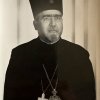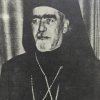Bishop Stefan was born September 14, 1908, in the village of Divos, Srem, into a priest’s family. He graduated from the Seminary in Sremski Karlovci and the Faculty of Orthodox Theology at Belgrade University in 1939. Prior to the election of Bishop, he served in the highest Church hierarchical and legislative institutions. Thus, he gained vast experience in Church legislature and administration.
After graduating from the Faculty of Theology, he was ordained deacon for the Cathedral in Belgrade and appointed secretary of the Ecclesiastical Court of Belgrade-Karlovci Metropolitanate. He remained at this position until 1951, when he was elected Secretary of the Holy Synod. Later he was appointed teacher at St. Sava Seminary in Rakovica. His strong, sonorous and melodic baritone attracted many faithful in Belgrade in those ‘bitter times’. He was very musical, a renowned Serbian composer. At one audition, Stevan Hristić tried to talk Bishop Stefan into being a professional singer. He remained faithful to the desires of his father and dedicated himself in the service to Church, and the Serbian people. With ordination to the priesthood in 1955, his life took a different course. He was appointed parish priest at St. Spyridon Church in Trieste, Italy. With his beautiful voice, he was an attraction to many Italians, citizens of Trieste. From Trieste, he came to Windsor, Ontario where he was appointed parish priest. The Holy Assembly of Bishops, at its session of May 11, 1963, elected Stefan Lastavica as the first Bishop of the newly created Eastern American and Canadian Diocese.
Protopresbyter Stefan Lastavica received the monastic tonsure and was elevated to the dignity of an Archimandrite in the chapel of the Venerable Mother Angelina of Serbia in Shadeland, Pennsylvania. He was consecrated Bishop in Aliquippa on July 13, 1963, by Bishops Chrysostom of Branicevo and Visarion of Banat. Bishop Stefan died after three years of leading the Diocese, on May 10, 1966, and was buried at the St. Elijah Serbian Cemetery in Aliquippa.
As an expert of Church music and singing, he made great contributions to the advancing of Serbian chant by arranging the Eight Tones (Octoechos) and Festal Chants. In the Triodion, he arranged the Three Stations of Holy Saturday Matins (sung on Good Friday evening). A part of the Triodion and Pentecostarion remained uncompleted, as his untimely death prevented him from completing the whole cycle of liturgical singing.
The beginning of his work was very difficult. His industrious labors and knowledge of church administration contributed to the establishment of a firm foundation for the nascent Diocese. The new Diocesan entities were formed per the Constitution of the Serbian Orthodox Church. The beginning of the Diocese of Eastern America and Canada was strained and uncertain, as was the beginning of Bishop Stefan’s archpastoral work.
The Eastern American and Canadian Diocese consisted of twenty-two American States and all of Canada in two Deaneries of the former Diocese: the Eastern American Deanery and Canadian Deanery. There were thirty-five Church School Congregations, twenty-nine Churches and thirty-three priests. Nine Church School Congregations with six Churches and twelve priests had decided not to accept the Decision of the Holy Assembly of Bishops. Of the six Canadian priests, only two remained loyal to the Mother Church. Since one was elected bishop, only one was in unity.
The intended See in Clairton, Pennsylvania, was not entirely welcoming, and he had no place to lay his head. “I have made a home for myself here in Windsor,” the late Bishop wrote to one of his friends, “but now it is time for me to go and meet new, greater and more difficult challenges and problems, the scope of which cannot be realized. I trust in God’s mercy that He will give me strength that I may worthily carry the burden which, by this election, has been placed on my unqualified shoulders…” He started literally from nothing. Following the example of the Holy Apostles, Bishop Stefan of blessed memory traveled from parish to parish, and his travels continued up to his unexpected illness.
Bishop Stefan organized all the necessary diocesan bodies. In time he succeeded in filling all the vacant parishes, ordaining four candidates to the holy priesthood. Through his labors and efforts, a new church-school congregation was established in London, Ontario, Canada. Bishop Stefan blessed three churches, three schools, five parish homes and two church halls. After three years Bishop Stefan moved the See of the Diocese from Clairton to Cleveland, Ohio, which demonstrates that he had moved everything forward, and that stabilization was proceeding in the Diocese according to plan in all areas of religious-national life and in administration. Bishop Stefan’s health soon began to decline. Afflicted with great concerns, strains, and misfortunes, and most of all by the unfortunate split of our Church on this continent, he died at age 58 in Cleveland, Ohio on May 10, 1966. He is interred in a place of honor at the St. Elijah Serbian Orthodox Cemetery in Aliquippa, Pennsylvania. Bishop Stefan left in his wake a sure and well laid foundation for the Diocese of Eastern America and Canada.
Епископ Стефан (Ластавица) (1963–1966)
Стефан Ластавица (Дивош, 14. септембар 1908 — Кливленд, 10. мај 1966) је био епископ источноамерички и канадски.Рођен је у свештеничкој породици. Отац Јова је био дуго година свештеник у Дивошу. Основну школу је завршио у родном селу, Богословију Светог Саве у Сремским Карловцима, а Богословски факултет у Београду.
Након завршетка Богословије био је службеник суда Архиепископије београдско-карловачке, а по рукоположењу у чин ђакона и секретар истог суда. За секретара Светог архијерејског синода изабран је 1951. године а на овом положају се није дуго задржао. Као један од најбољих познавалаца српског народног црквеног појања, постављен је наставника појања у Богословији Светог Саве у Београду.
Пред одлазак у Трст за пароха (1956) рукоположен је у чин презвитера и произведен у чин протојереја. У Трсту се није могао дуго да задржи због ситуације која је тада била у овој црквено-школској општини, те је отишао за пароха у Виндзор (Канада). На овом положају га је затекао избор, 11. маја 1963. године за епископа источноамеричког и канадског. Хиротонисали су га 13. јула 1963. године у Аликвипи браничевски епископ Хризостом и банатски Висарион.
Одличан певач (драмски баритон) са личним стилом у појању и изузетно музикалан, почео је да се бави мелографским радом и решио да изда Осмогласник (1951). Радећи на њему, у предговору каже: „Старао сам се да ускладим мелодиски нагласак са нагласком српског језика, али не по сваку цену, па и по цену да се изгуби карактер гласа. Стога има места у овом Осмогласнику где се за љубав језичког акцента није могла жртвовати утврђена мелодиска линија.“ Осмогласник је објављен епископова живота, а Празнично појање, у два тома, издала је Епархија источноамеричка и канадска у редакцији проф. Војислава Илића (1969). Према записима епископа Стефана, проф. Илић је за хор хармонизовао све три статије које је такође издала источноамеричка и канадска епархија.
Неколико месеци пред смрт пренео је седиште Епархије источноамеричке и канадске из Клертона (Пенсилванија) у Кливленд (Охајо). Сахрањен је на српском православном гробљу у Аликвипи.
Извор: Википедија






